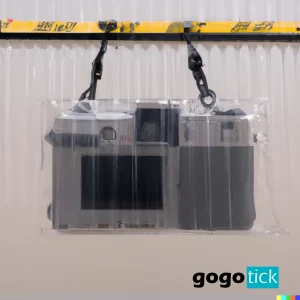A tight lens can slow down shooting, cause issues with focus, and could be a signifier of larger issues. Luckily, stiff lenses are a fairly common issue and a few simple steps can be taken to fix the issue most of the time.
Lenses can become stiff for a number of reasons, such as being unused for a while or being stored in a cold area. It is also possible that the lens shipped out stiff and some loosening is necessary. Regardless of the reason, there are simple, easy steps that can be taken to make refocusing lenses easier. But if you want to protect your lenses from this type of problem, we recommend that you get one of these accessories that are on sale at amazon.
How to Loosen Up a Camera Lens that is Hard to Turn
It is important to remember, while loosening a stiff lens, that they are highly advanced pieces of technology. It can be easy to accidentally break a lens if uncareful while trying to fix it, so be sure to take your time and only do what feels comfortable. If something feels amiss or another problem pops up, it may be worthwhile to take the lens to a repair professional.
Rotate The Lens Focus Ring
The first step any photographer should take toward loosening a lens is simply rotating in the hands for a while. When lenses go a long time in between uses, it is possible for the focus rings to dry out and stiffen up.
All lenses come with lens oil around the focus rings, and rotating the lens for a little while can often reintroduce this oil and lubricate everything properly again.
This rotation can take a while if the lens is particularly stiff. Taking an extra 10 or 15 minutes to simply rotate the lens can help fix a large variety of stiffness issues and may actually solve the whole issue.
If the lens is simply not budging at all, it is best to move on to another step and then come back to rotating the lens. However, if you are getting any movement at all, be patient and try to let the lens fix itself.
Warm The Lens In Your Hands
Often, cold temperatures can cause issues with lenses and make them stiffen up. Most of the time, this can be solved by warming the lens focus ring with your hands and rotating it constantly until the problem is solved.
To warm the lens, cup it in between your two hands for a few minutes. Every so often while you are doing this, attempt to rotate the lens so that the heat is spread evenly. This will also let you test and see if your body heat is helping to solve the issue or not.
If you are trying to loosen the lens while in a cold area, try to wear warm gloves or find something to warm your hands while you do this. Otherwise, your hands will likely not provide enough heat to solve the issue.
Be sure to rotate the lens while warming it in your hands. Not only will this keep your hands moving, allowing them to keep warm, but it will also spread heat more evenly and allow you to test the lens.
As the lens warms up and loosens, keep warming with your hands for a little while longer. This will keep the heat longer than otherwise.
If your body heat is not working, it is possible you will need a larger heat source to help the lens deal with the cold.
Use Heat From A Hairdryer To Warm The Focus Ring
The next step after warming the lens with your hands is to warm the lens with a hotter source such as a hairdryer. Be warned that this should not be a very hot source, as it could cause further issues in the lens such as warping or bending.
A hairdryer works best due to its portability, movability, and adjustable heat.
Hold the hairdryer at least 6 inches away from the lens on low heat. Rotate the lens entirely so that the heat does not focus on one area and cause possible warping. Do not do this for too long. For the first pass, simply hit every part of the lens with the heat and then attempt to rotate it for a while.
The heat from the hairdryer is intended to liquidate the dried lubricant that should be present in the lens. Generally, using a hairdryer should not be necessary over simple hand heat unless you are in an extremely cold area or the lens was stored in a cold area for a while.
If the first pass from the hairdryer did not work, keep heating it steadily on low heat. It is important to not get impatient and turn to high heat or hold the hairdryer close, as this can break the lens entirely. Be patient and pause often to try and turn the lens.
If no heat method or simple rotation is working, it is possible the lens has run out of lubricant and it needs to be reapplied.
Lightly Lubricate The Focus Lens
Applying lens lubricants in extremely light quantities can help to fix a stiff lens and keep it working for a while to come. This is a more complicated process and may require special tools depending on what manufacturer made your lens.
The method for greasing your lens at home is fairly easy but should be done with care, as messing up could get oil into other parts of the lens.
To start, take a small, clean cloth and some lenses grease. It is important to only use greases intended for lenses. Other lubricants such as WD-40 could cause issues in the lens if it leaks onto other parts. In addition, try to match the lubricant to your model of lens. Older lenses, for instance, tend to use a different grease. Changing greases could cause issues to arise.
Drop two to four drops of lens grease over the focus ring, rotating slowly in between drops. Once the drops are placed around the outside, take the clean cloth and gently rub them into the focus ring. This should hopefully spread the lubricant full around the lens’ ring and allow for easy focusing.
Once the grease has been rubbed in, take the extra time to rotate the lens fully a few times. The action should feel easier but may still not be perfect. It is important to give the grease time to settle in and reach the entire focus ring, so let the lens sit for at least 24 hours.
If the lens is still not rotating properly after all of these steps, it is best to contact a professional as further steps will require opening the lens up.
Contact A Lens Repair Professional
Contacting a lens repair professional is the best bet if the other steps have failed or if the lens is still under warranty. Often, they will be able to identify the problem quickly and have the necessary tools on hand to solve the issue.
Check if the lens is still under warranty before starting this process. While you can get the lens fixed even if it is not, being under warranty could save you significant money.
This option will take the longest amount of time and you will often have to ship the lens away for a few weeks. Be sure to have a backup lens during this time so you can keep shooting.
It is often best to go directly to the company that manufactured your lenses, such as Canon or Nikon. This is especially true if the lens is still covered by the manufacturer’s warranty. If not, however, going to a local camera shop could result in cheaper or quicker repairs.



































